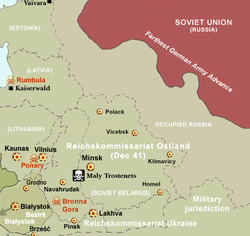Maly Trostenets


Maly Trostinek o Maly Trostenets (ruso: Малы Трасцянец) fue un campo de exterminio nazi situado en Bielorrusia. Fue creado el 7 de mayo de 1942 y cerrado el 10 de enero de 1943. Se estiman en 206.000 los muertos en él. Estuvo dirigido por Karl Streibel.
Historia[editar]
Maly Trostinek era un campo dedicado al asesinato masivo de judíos bielorrusos así como los de las zonas de Minsk y de los alrededores. Es difícil saber con exactitud el número de víctimas en Maly Trostinek ya que los nazis destruyeron toda la documentación relativa tanto al campo como al personal S.S. y auxiliar destinado al mismo.
Si a mediados de julio de 1941 habitaban unos 400.000 judíos en Bielorrusia, se estima que el 80% fueron exterminados por asesinatos masivos en el bosque de Blagowshtchina, en donde murieron unos 50.000 judíos y en el bosque de Shashkowa (a 5 kilómetros de Maly Trostinek) en donde se ejecutó a unas 100.000 personas, o por la deportación a otros campos de exterminio. Allí perecieron la soprano Grete Forst, la psicoanalista Margarete Hilferding y el sacerdote católico Vincent Hadleŭski.
Referencias[editar]
Bibliografía[editar]
- Ernst Klee, Willi Dressen, “Gott mit uns”: Der deutsche Vernichtungskrieg im Osten, 1939–1945 (Frankfurt am Main, S. Fischer, 1989).
- Shmuel Spector, ‘Aktion 1005 — Effacing the Murder of Millions’, Holocaust Genocide Studies (Oxford)
- Paul Kohl, Der Krieg der deutschen Wehrmacht und der Polizei, 1941–1944: sowjetische Überlebende berichten
- Christian Gerlach, Kalkulierte Morde: Die deutsche Wirtschafts- und Vernichtungspolitik in Weißrußland 1941 bis 1944 (Hamburg, Hamburger Edition, 1999).
- Leonid Smilovitsky, ‘Ilya Ehrenburg on the Holocaust of the Jews in Belorussia: Unknown Evidence’, East European Jewish Affairs
- Hans Safrian, ‘Expediting Expropriation and Expulsion: The Impact of the “Vienna Model” on Anti-Jewish Policies in Nazi Germany, 1938’, Holocaust Genocide Studies (Oxford), vol. 14 (2000)
- [Ė.G. Ioffe, G.D. Knat’ko, V.D. Selemenev, comps.], Kholokost v Belarusi, 1941–1944
- [V.I. Adamushko, et al., comps.], Лагерь смерти “Тростенец”: Документы и материалы 2003) ISBN 985-6372-30-5].
- [K.I. Kozak, et al., eds.], Henatsyd u druhoĭ susvetnaĭ vaĭne: Prablemy dasledavanniya u pamiyats akhviyar Trastsiyantsa... (Minsk, Vydavetski tsentr BDU, 2003)
- S.V. Zhumar’ & R.A. Chernoglazova, comps., Trostenets (Minsk, GK ‘Poligrafoformlenie’, 2003 Library of Congress call No. D805.5.M358 T76 2003].
- Igor’ Kuznyetsov, ‘В поисках правды, или Трагедия Тростенца: до и после’ [In Search of Truth; or, The Tragedy of Trostenets: Before and After], Belorusskaya delovaya gazeta [Belarus Business News] (Minsk), No. 1416 2004 Minsk, 1999–2002)
- Petr Krymsky, ‘Тростенец — белорусский “Oсвенцим”’ Trostenets — Belarusian ‘Auschwitz’, Rossiĭskie vesti [Russian News] (Moscow), No. 16 (1771), May 11–18, 2005
- [Z.R. Iofe, et al., eds.], Laher smertsi Tras’tsyanyets, 1941–1944 hh.: pamiyatsi akhviyar natsyzma ŭ Belarusi [The Tras’tsyanyets Death Camp, 1941–1944: In Memory of the Victims of Nazism in Belarus]
- Poliakov, Leon. Harvest of Hate: The Nazi Program for the Destruction of the Jews of Europe Syracuse University Press, 1956
- Buscher, Frank. Investigating Nazi Crimes in Byelorussia: Challenges and Lessons Justiz und NS-Verbrechen
- Gerlach, Christian. Kalkulierte Morde. Die deutsche Wirtschafts- und Vernichtungspolitik in Weißrußland 1941-1944, Hamburg 1999
- Kohl, Paul. Trostenez - Das Vernichtungslager bei Minsk In: "Existiert das Ghetto noch? Weißrußland: Jüdisches Überleben gegen nationalsozialistische Herrschaft." Projektgruppe Belarus. Berlin-Hamburg-Göttingen 2003.
- Langenheim, Henning. Mordfelder Elefanten Press, Berlín 1999
